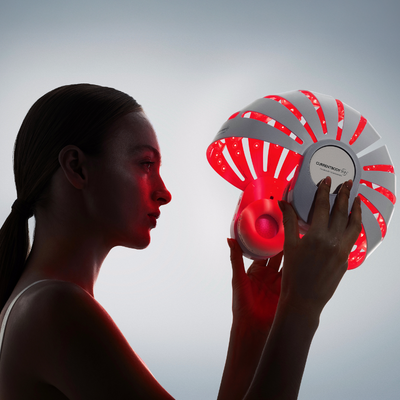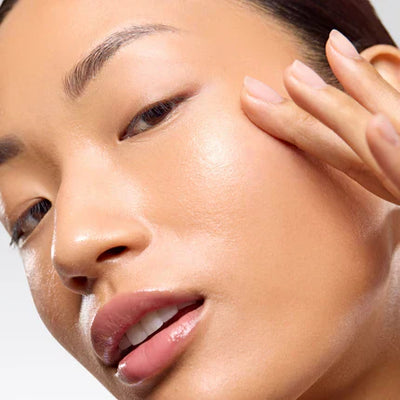Discover how to treat rosacea and redness at home.
Rosacea is a common but often misunderstood skin condition that affects millions of people worldwide. Characterized by facial redness, visible blood vessels and sometimes acne-like bumps across the cheeks, nose and chin, rosacea can be extremely distressing.
Following the advice of board-certified dermatologists, Dr. Shah and Dr. Maxfield, we explore the four subtypes of rosacea, potential triggers, symptoms and the best rosacea treatments that can be easily done at home.
In this piece, we’ll discover exactly how to avoid future flare-ups so you can achieve your best skin yet.

What causes rosacea?
The cause of rosacea isn't known, but an overactive immune system, genetics and inflammatory ‘triggers’ can all contribute.
Flare-ups can be caused by drinking alcohol, eating spicy foods or being out in the sun for too long. Simply put, anything that stimulates new blood vessels to grow and spread roots, over time, may ultimately result in rosacea.
While there's no cure, rosacea can be controlled. To effectively tackle the symptoms of rosacea, you must first identify your rosacea subtype.
What are the subtypes of rosacea?
“Rosacea is a trial and error type of condition,” says Dr. Maxfield. “Each subtype behaves differently.”
ETR (erythematotelangiectatic) rosacea is distinguished by persistent facial redness—when you're flushed for over 30 minutes.
“Treat your skin as if it’s sensitive. Avoid skincare and makeup containing isopropyl alcohol, witch hazel, essential oils, as well as mechanical scrubs.”
Instead, opt for licorice, niacinamide and barrier-strengthening ceramides. And always slap on the factor 50.
The second subtype looks a bit like acne—but don’t be fooled, using retinol on this type of rosacea can make it much, much worse. Papulopustular rosacea shows up as small red pus-filled bumps, often scattered across the midface. Sulphur is “very, very effective” and is “probably one of the most underrated skincare ingredients that exists,” says Dr. Shah.
Thirdly, phymatous rosacea, which continuously grows oil glands that eventually thicken the skin tissue, is something you need to tackle early on. Dr. Shah recommends niacinamide to decrease oil production and shrink pores, but only as a preventative before you consult with your dermatologist.
And lastly, ocular rosacea symptoms can be as small as a crustiness along your lash line, a ‘gritty’ sensation like sand or frequent styes on the eye margin. “A lot of times, people don’t even realise that it’s a part of rosacea, and they take a long time to seek care,” explains Dr. Maxfield. See your ophthalmologist or dermatologist to get this type of rosacea under control.

Does red LED light help rosacea?
Absolutely. You might’ve spied this beauty tech in magazines or while scrolling down your feed; most commonly seen in the form of futuristic light-up face masks.
LED (light-emitting diode) light therapy is proven to reduce inflammation—essential for soothing all rosacea subtypes—and kicks your ‘wound healing’ cells into gear. It’s a staple in the dermatologist’s office, and now we’re seeing the same trusted technology in home use devices.
Our original Red Light Face Mask is incredibly effective at reducing facial redness and facial flushing from ETR rosacea. Evidence-based red (633nm) and near-infrared (830nm) wavelengths target the inflammation directly in what feels like a soothing 10-minute light bath. And for those with ocular rosacea, our LED Eye Perfector acts as a more eye focused anti-inflammatory treatment.
Some LED wavelengths even provide pain relief.

AJ suffered with papulopustular rosacea for five years. At best, she had persistent facial redness, and at worst, she was experiencing large clusters of extremely painful spots with a 'fiery itchiness'. After using blue (415nm) and near-infrared (830nm) light for around two or three times a week, AJ noticed a massive reduction in her redness and painful spots.
“I don’t want to constantly take medication, so, in addition to understanding and identifying my triggers (along with a skincare range that really helps), I’m finding the Dermalux Flex completes my skincare routine and greatly helps with managing my rosacea symptoms.”
- AJ.
For phymatous rosacea, you’ll need to control your oil production. Our multi light therapy mask uses green (532nm) and near-infrared (830nm) light in the ‘brightening’ treatment, which is fantastic at balancing oil.
Amongst the four treatment modes available, we also recommend ‘restoring’—a blend of yellow (590nm) and near-infrared (830nm) light designed to reduce water loss and improve your skin’s moisture. The increased water content prevents dehydration, giving your oil glands no reason to compensate for water loss.
How to get rid of redness and rosacea?
If you’re experiencing redness or rosacea, it can be difficult navigating through skincare products that don’t aggravate your skin. And while LED treatments for rosacea are proven to help with symptoms, consult with your dermatologist, ophthalmologist or skin expert to get an at home rosacea treatment plan tailored to you.




